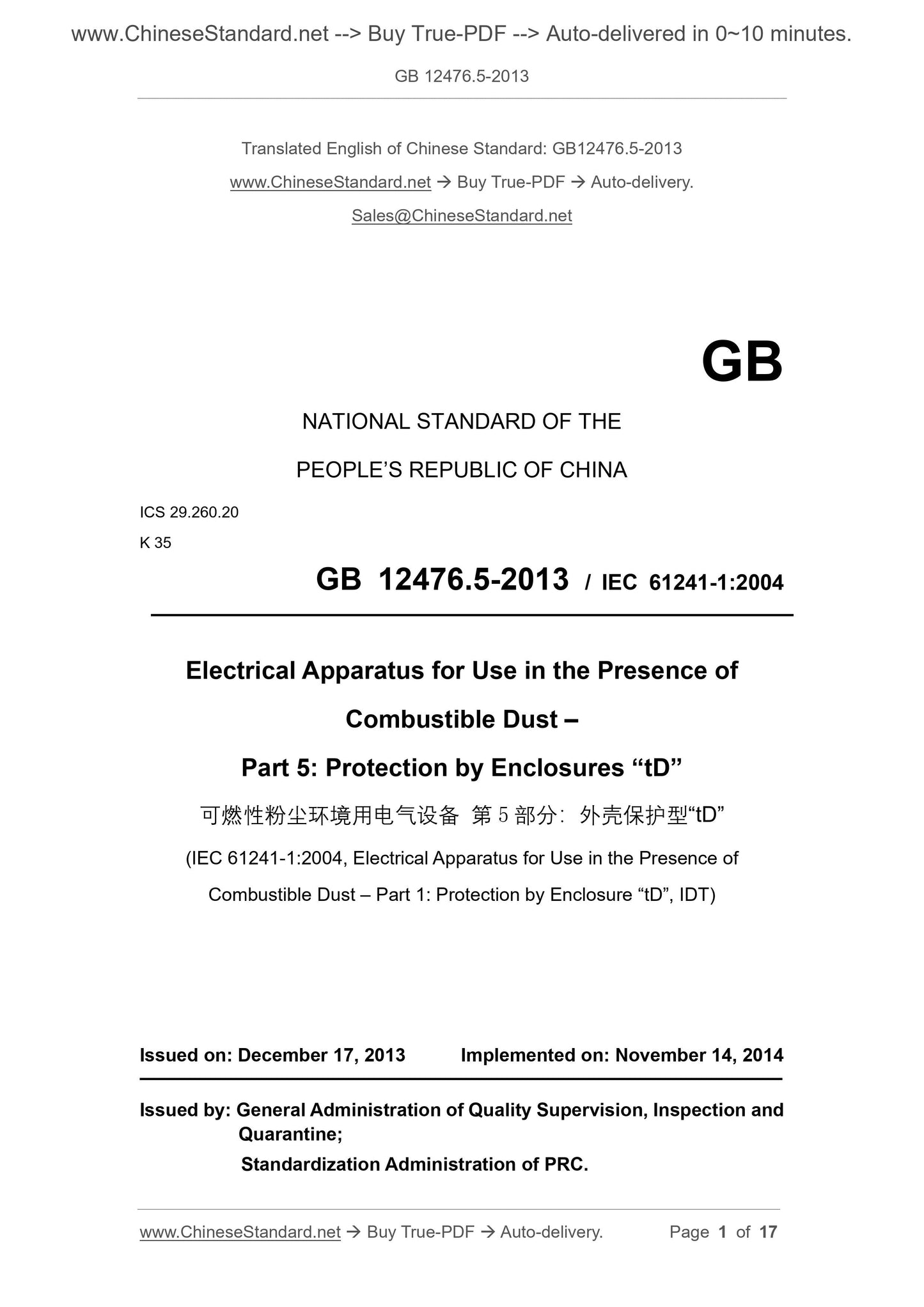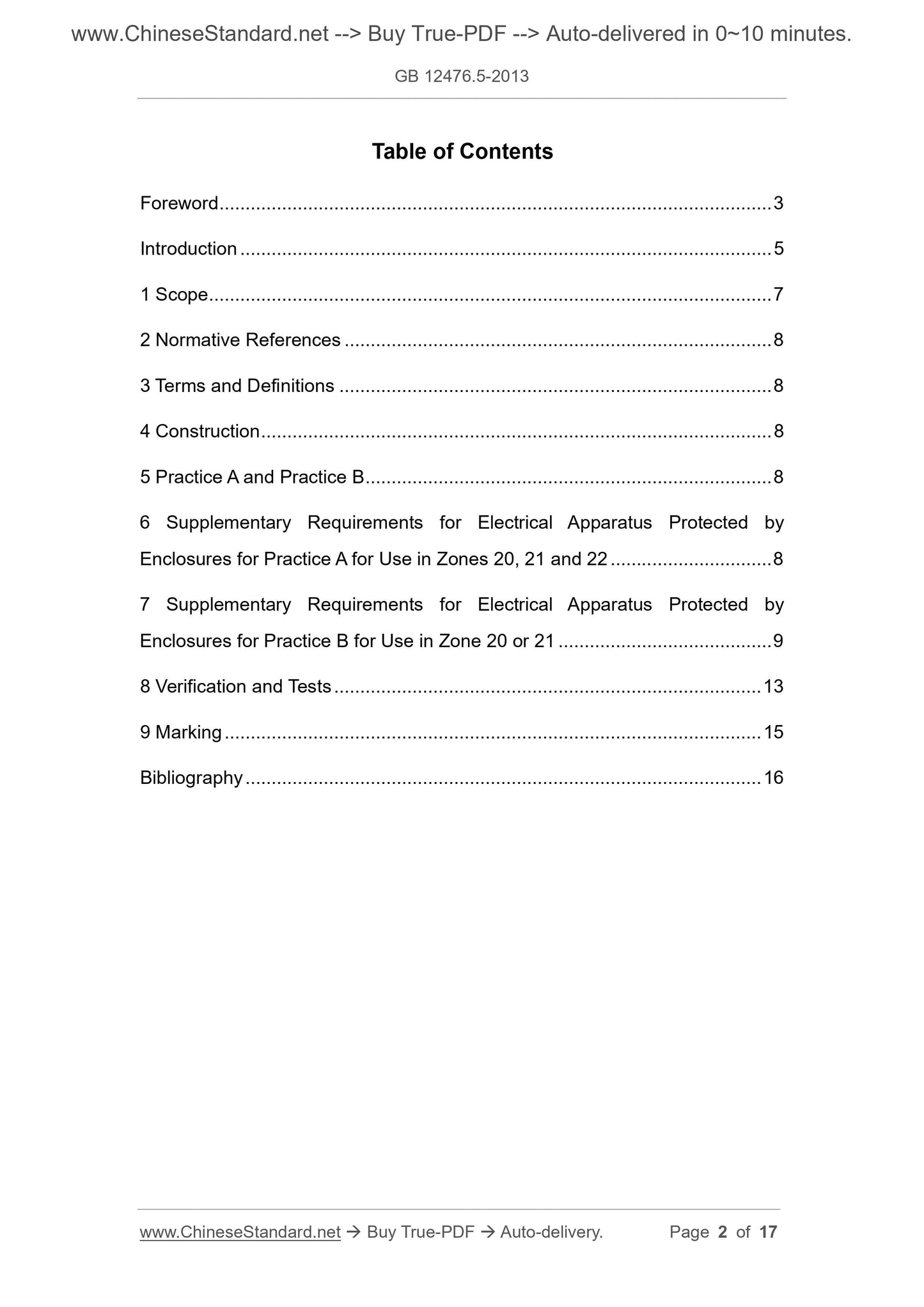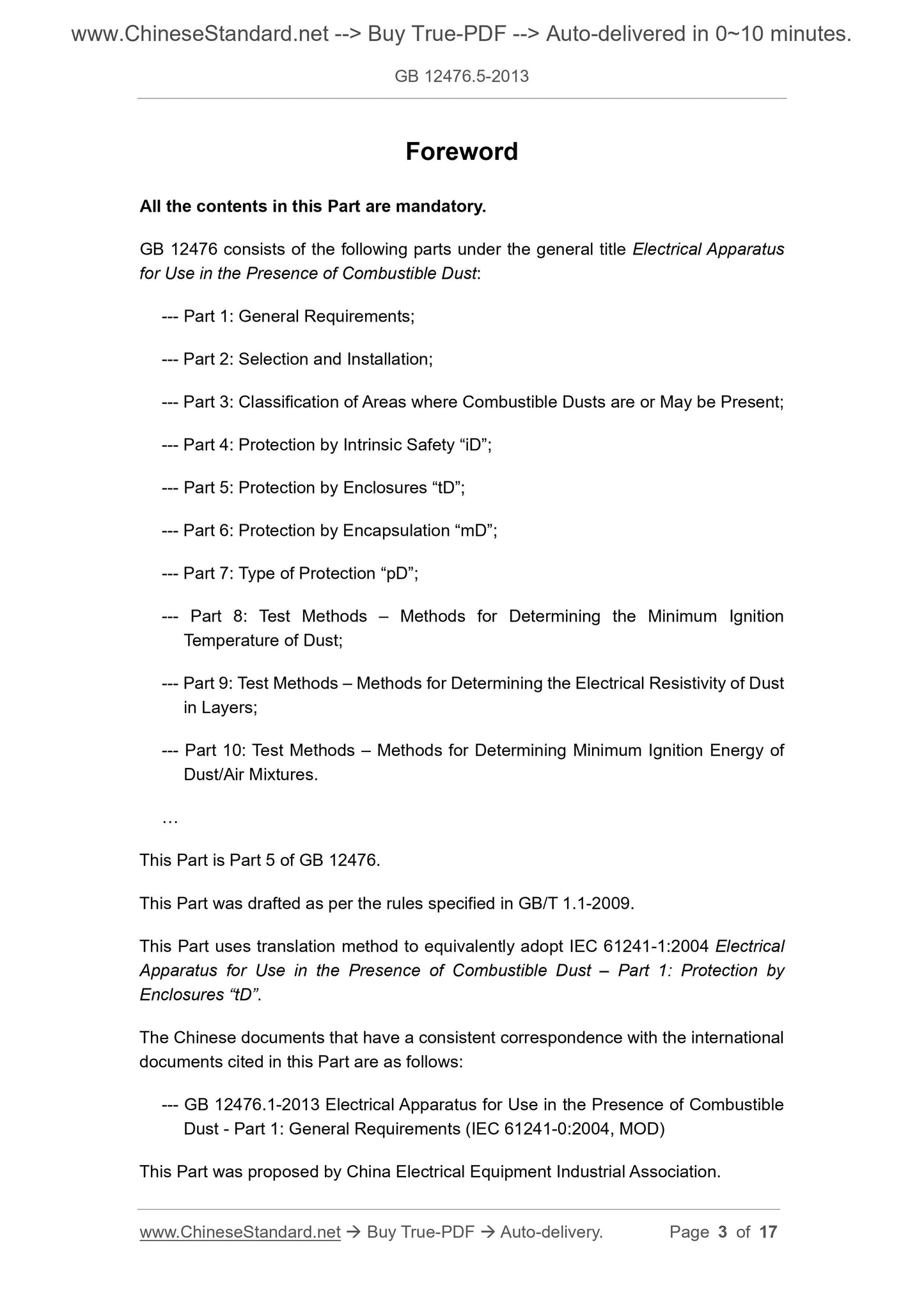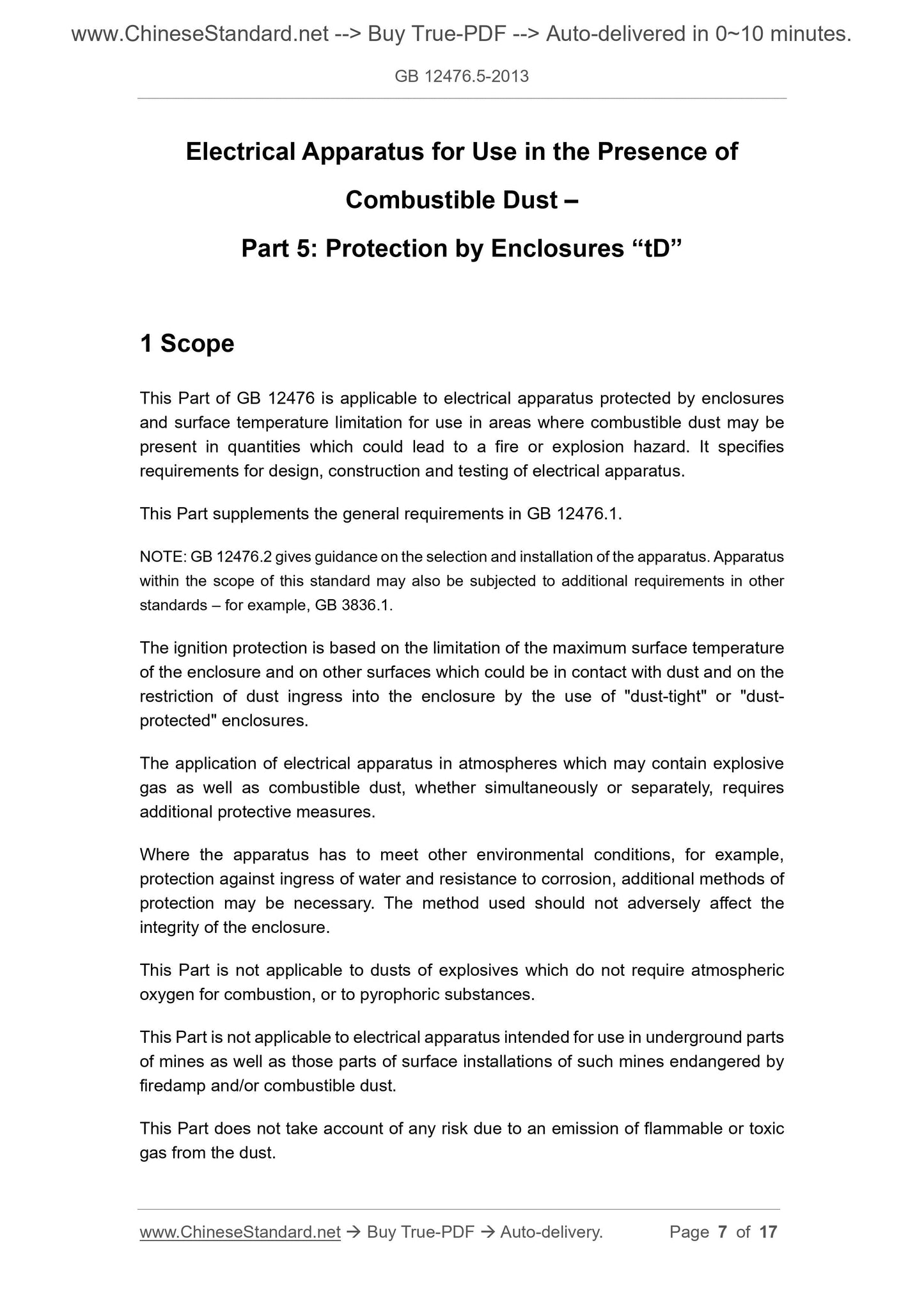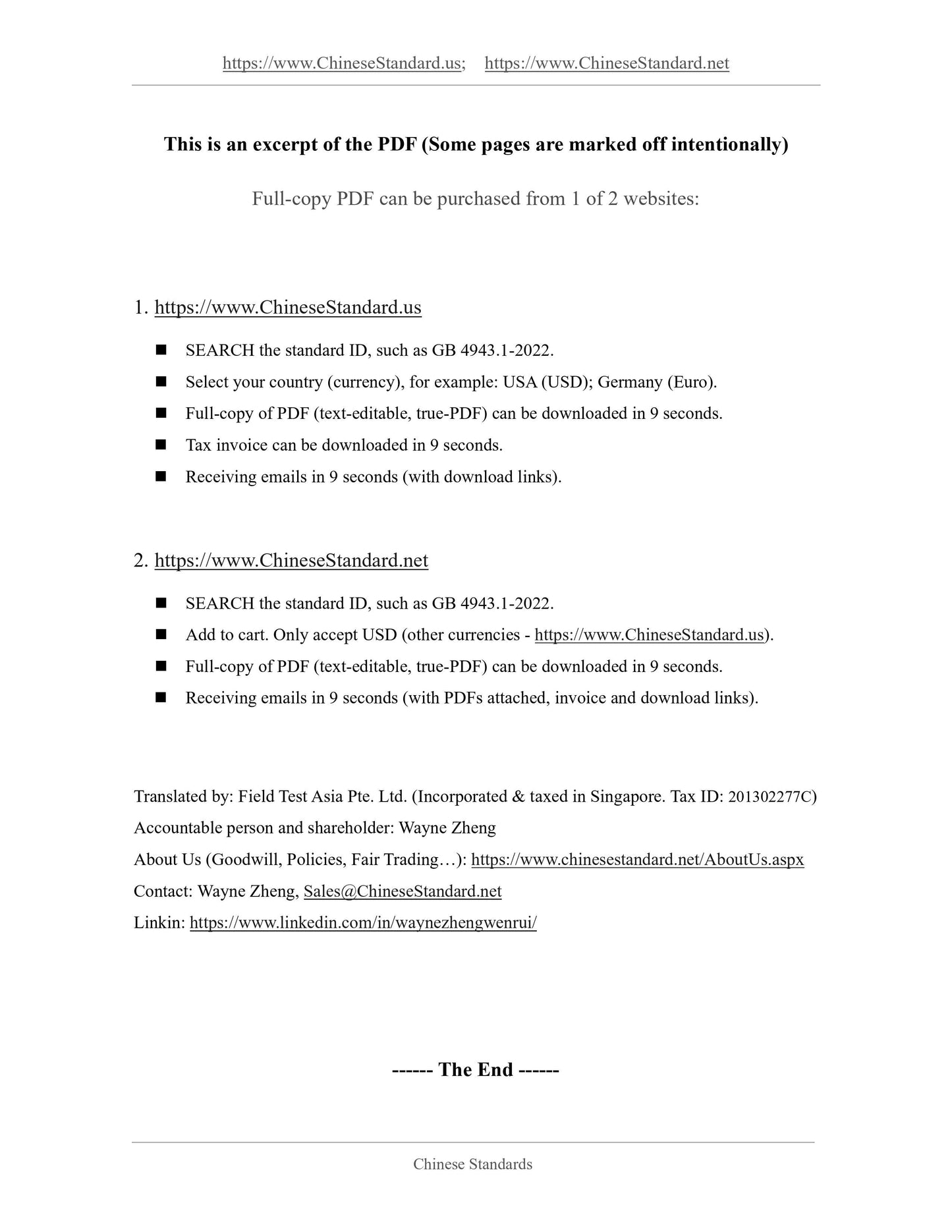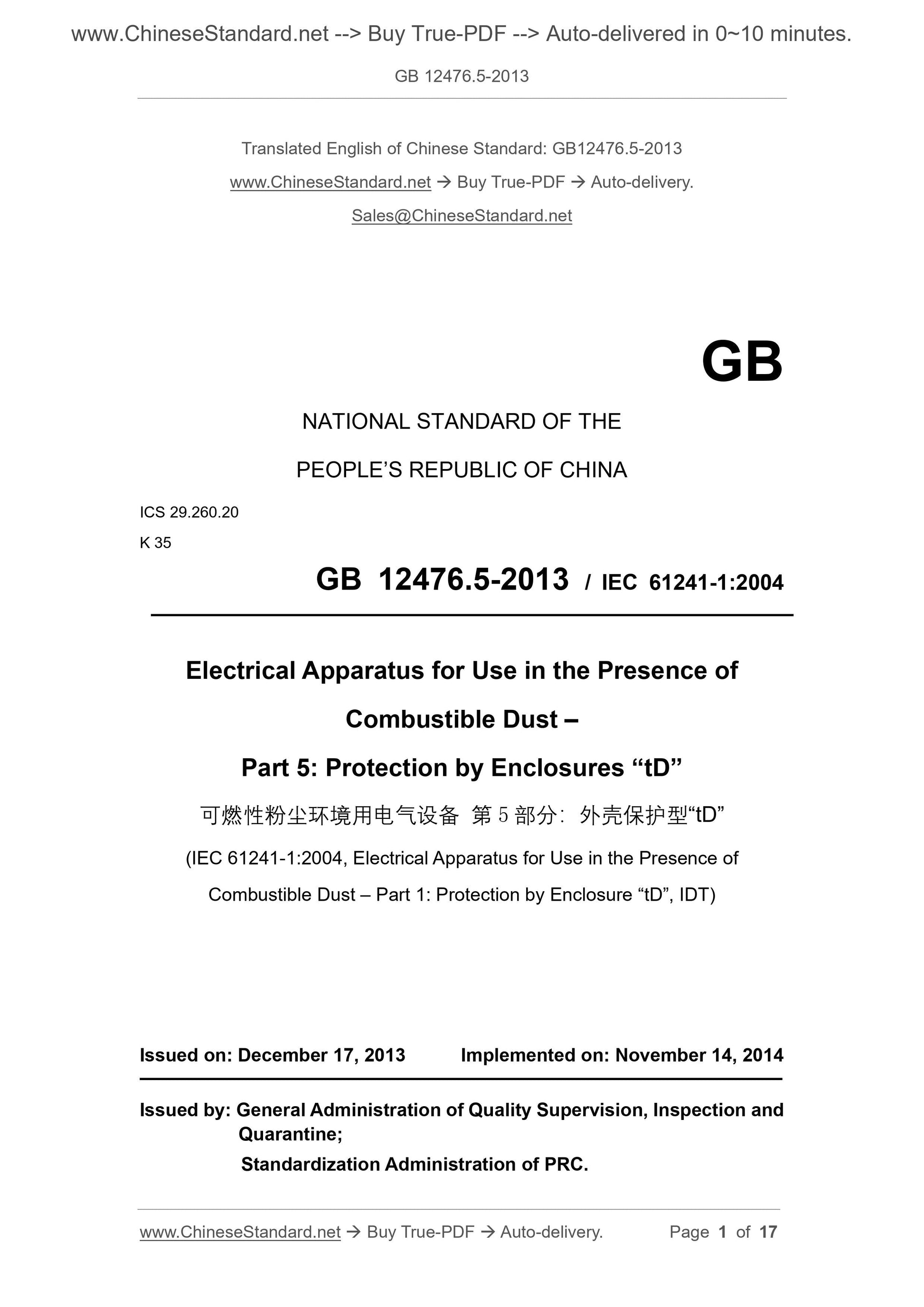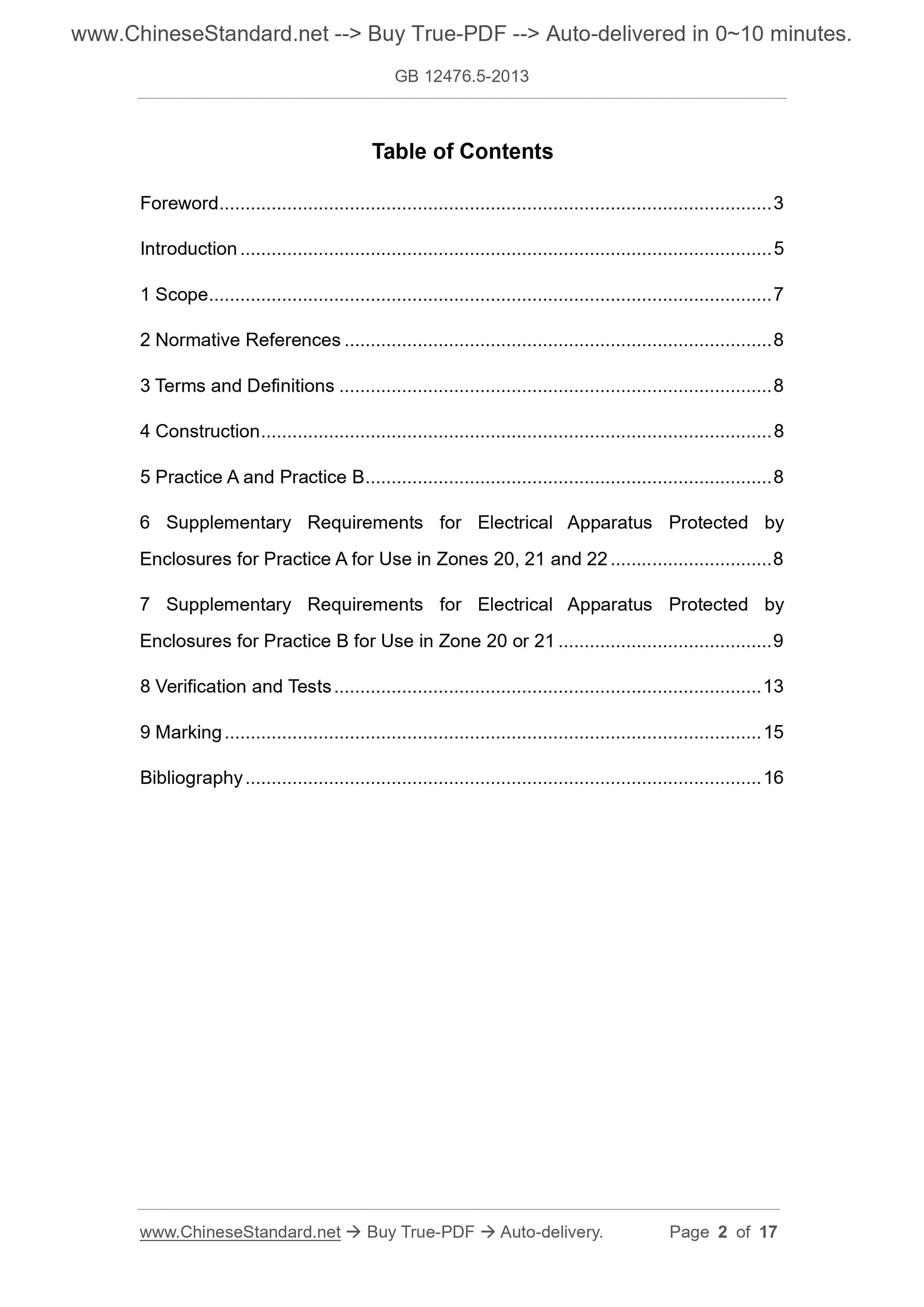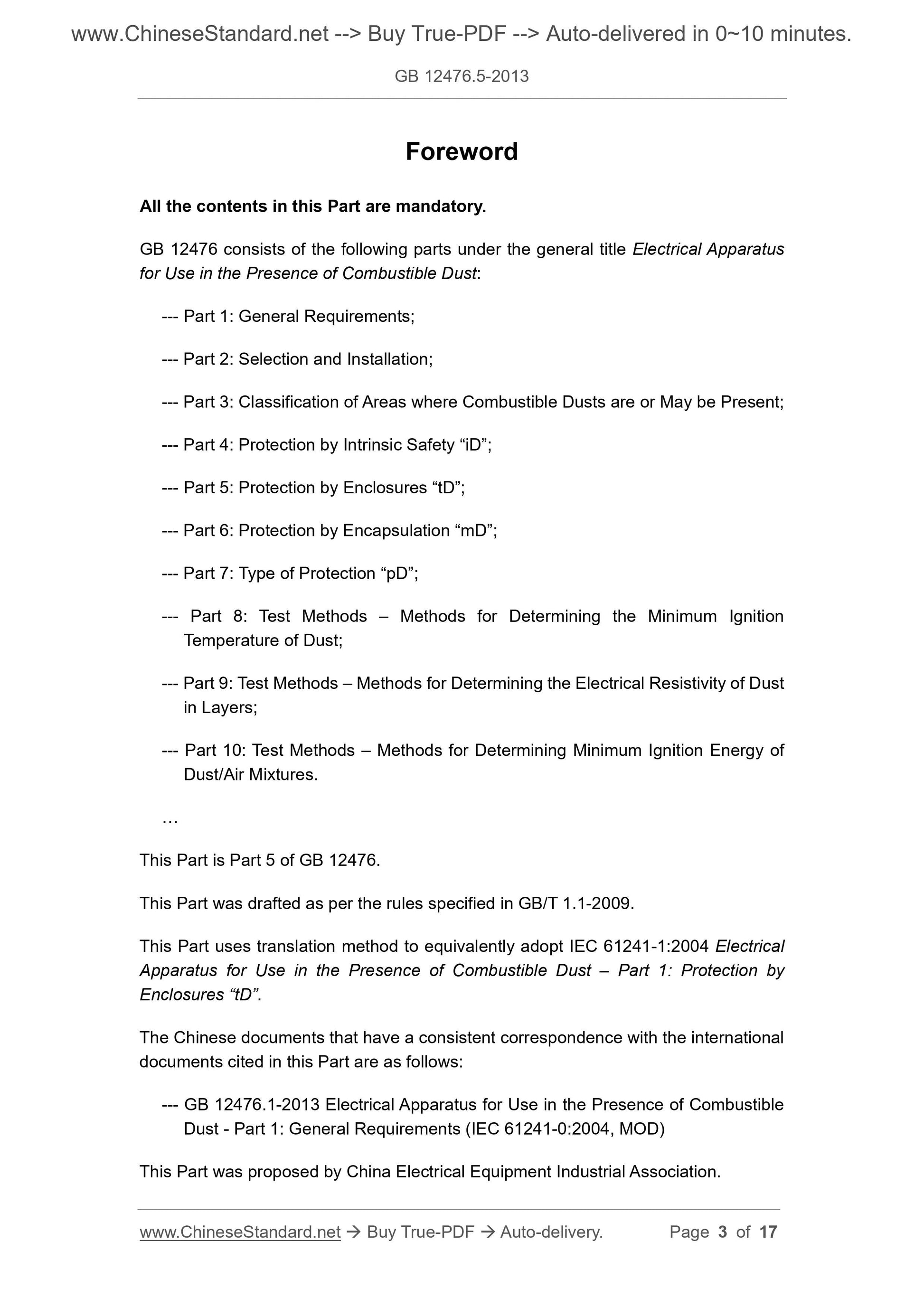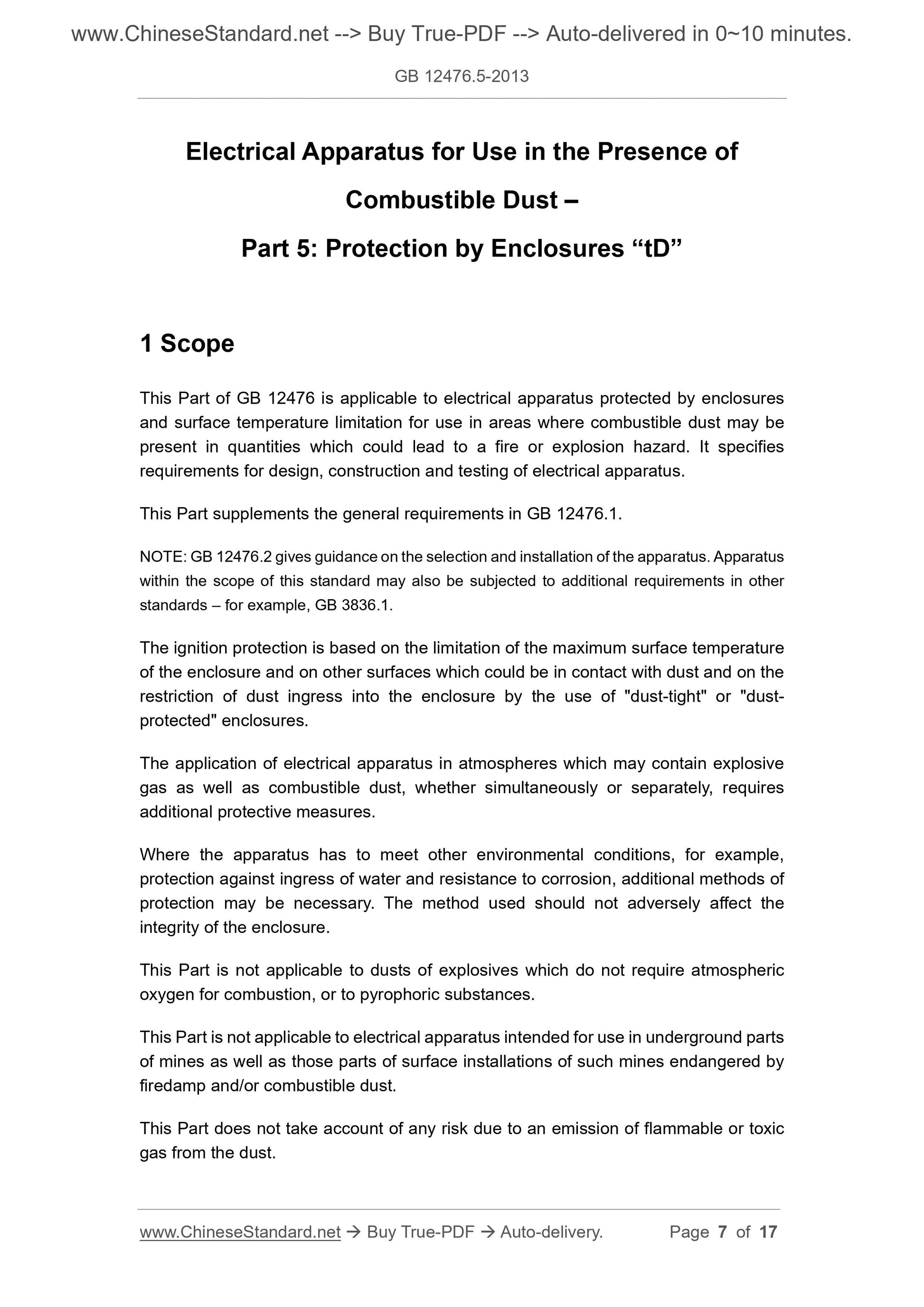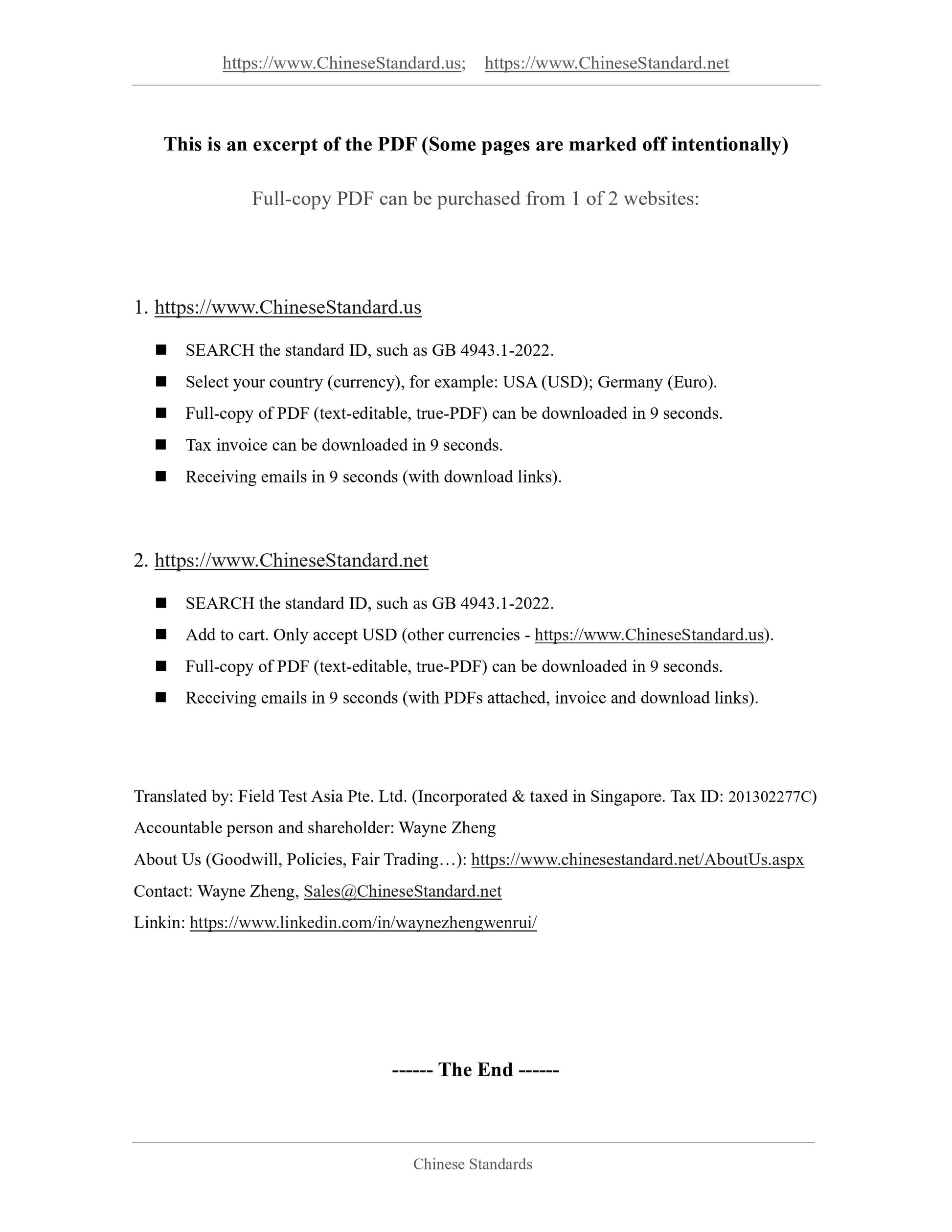1
/
de
5
PayPal, credit cards. Download editable-PDF and invoice in 1 second!
GB 12476.5-2013 English PDF (GB12476.5-2013)
GB 12476.5-2013 English PDF (GB12476.5-2013)
Prix habituel
$170.00 USD
Prix habituel
Prix promotionnel
$170.00 USD
Prix unitaire
/
par
Frais d'expédition calculés à l'étape de paiement.
Impossible de charger la disponibilité du service de retrait
Delivery: 3 seconds. Download true-PDF + Invoice.
Get QUOTATION in 1-minute: Click GB 12476.5-2013
Historical versions: GB 12476.5-2013
Preview True-PDF (Reload/Scroll if blank)
GB 12476.5-2013: Electrical apparatus for use in the presence of combustible dust -- Part 5: Protection by enclosures “tD”
GB 12476.5-2013
Electrical apparatus for use in the presence of combustible dust.Part 5. Protection by enclosures "tD"
ICS 29.260.20
K35
National Standards of People's Republic of China
Electrical equipment for combustible dust atmospheres
Part 5. Housing protection type "tD"
Electricalapp Русский
Part 5. Protectionbyenclosures "tD"
(IEC 61241-1..2004, Electricalapp)
combustibledust-Part 1. Protectionbyenclosures "tD", IDT)
2013-12-17 release
2014-11-14 implementation
General Administration of Quality Supervision, Inspection and Quarantine of the People's Republic of China
China National Standardization Management Committee released
Preface
The entire contents of this section are mandatory.
GB 12476 "Electrical Equipment for Combustible Dust Environment" is divided into several parts.
- Part 1. General requirements;
- Part 2. Selection and installation;
- Part 3. Classification of hazardous places in the presence or presence of combustible dust;
- Part 4. Intrinsically safe "iD";
- Part 5. enclosure protection type "tD";
- Part 6. Type of enclosure protection "mD";
- Part 7. Positive pressure protection type "pD";
- Part 8. Test methods - Method for determining the minimum ignition temperature of dust;
- Part 9. Test methods - Determination of resistivity of dust layer;
- Part 10. Test methods - Determination of minimum ignition energy for dust and air mixtures;
This part is part 5 of GB 12476.
This part is drafted in accordance with the rules given in GB/T 1.1-2009.
IEC 61241-1..2004 "Electrical equipment for combustible dust atmospheres" Part 1. Protective enclosure
Type "tD" ".
In this part of the normative reference to the international documents have a consistent correspondence between the following documents.
GB 12476.1-2013 Electrical equipment for combustible dust atmospheres - Part 1. General requirements (IEC 61241-0..2004,
MOD).
This part is made by China Electrical Equipment Industry Association.
This part of the national explosion-proof electrical equipment Standardization Technical Committee (SAC/TC9) centralized.
This part of the main drafting unit. Nanyang explosion electrical research institute.
This part of the main participating units. National Explosion-proof electrical products Quality Supervision and Inspection Center, Shenzhen Tean Electronics Co., Ltd., Huarong Group
Limited liability company, Henan Huanghe Explosion-proof Crane Co., Ltd., Changzhou Yuhua Electronic Equipment Co., Ltd., is a explosion-proof Electric Co.,
The main drafters of this part. Wang Jun, Li Shuzhao, Chen Rui, Hu Linzhong, Wang Ping, Huang Jianfeng, Li Jiang, Zhou Jinliang.
introduction
Many of the dust produced in the production, processing, transportation and storage is flammable. If the dust and air are mixed in appropriate proportions, point
The dust can burn quickly to produce a huge explosion pressure. In places where such combustible materials may be present, they are usually required
Explosion-proof electrical equipment, and therefore must take appropriate precautions to ensure that all electrical equipment is adequately protected to reduce the ignition of the external
The possibility of an explosive environment. Potential sources of ignition in electrical equipment include arcs, sparks, hot surfaces, and friction sparks.
Dangerous quantities of dust, fibers and flying places in the air are dangerous places and are divided into three hazards according to the hazard level
area.
In general, one of the following two methods is used to ensure the electrical safety of electrical equipment. a method (if practicable)
Installed in a dangerous place, another method in accordance with the electrical equipment used in the recommended method of design, installation and maintenance.
Electrical equipment may ignite flammable dust through the following main ways.
- The surface temperature of the electrical equipment is higher than the minimum ignition temperature of the relevant dust. Dust ignition temperature and dust performance, dust exists
State, the thickness of the dust layer and the geometry of the heat source;
Arcs or sparks of electrical components such as switches, contacts, rectifiers, brushes and similar parts;
Accumulated electrostatic discharge;
--- Radiant energy (eg electromagnetic radiation);
--- mechanical sparks related to electrical equipment, friction spark or friction heat.
In order to avoid the risk of ignition should do the following.
- the temperature of the surface of electrical equipment that may accumulate dust or may be in contact with the dust cloud shall be maintained at the temperature limits specified in this section
the following;
- any parts that produce spark or parts whose temperature is higher than the above temperature limit
● placed in a shell that is sufficient to prevent dust from entering;
• limit the energy of the circuit to avoid the generation of arcs, sparks or temperatures that can ignite flammable dust;
--- avoid any other ignition source.
If the electrical equipment is operated under its rated conditions and is installed and maintained in accordance with the applicable regulations or requirements,
Flow and internal short-circuit faults and other electrical faults, the protection method specified in this section will meet the required level of safety. especially important
Is to limit the severity and duration of internal or external failures to values that can not maintain damage to the electrical equipment.
Hazardous places in the use of several electrical equipment explosion-proof technology. This part describes the safety characteristics of the explosion-proof type, which stipulates the mining
Take the request. To ensure the safety of electrical equipment in hazardous locations, it is most important to comply with standard selection and installation procedures.
In this section, the shell protection "tD" specifies two different types. Type A and Type B, both of which have the same protection
Level.
Type A and Type B are common in both types and are not required to be confused by both types of equipment requirements and selection/installation.
begging. They use a different method, the main difference is.
Type A Type B
Mainly prepared according to the performance requirements mainly prepared according to the normative requirements
The maximum surface temperature is in the case where the thickness of the relevant dust layer is 5 mm
Under the test, and the installation procedure requires the temperature of the dust surface and the ignition temperature
Between the safety margin of 75K
The maximum surface temperature is in the case where the thickness of the relevant dust layer is 12.5 mm
Under the test, and the installation procedure requires the temperature of the dust surface and the ignition temperature
The safety margin is 25K
Method for determining dust entry According to GB 4208-IP code, the method for measuring dust entry is determined by the thermal cycle test
Electrical equipment for combustible dust atmospheres
Part 5. Housing protection type "tD"
1 Scope
This part of GB 12476 is applicable to electrical equipment which is protected by a housing and a restricted surface temperature in a flammable dust environment. In the ring
The presence of flammable dust can cause a fire or explosion hazard. This section specifies the design, construction and testing of electrical equipment
Claim.
This part is a supplement to the general requirements of GB 12476.1.
Note. GB 12476.2 gives guidelines for the selection and installation of electrical equipment. Electrical equipment wit...
Get QUOTATION in 1-minute: Click GB 12476.5-2013
Historical versions: GB 12476.5-2013
Preview True-PDF (Reload/Scroll if blank)
GB 12476.5-2013: Electrical apparatus for use in the presence of combustible dust -- Part 5: Protection by enclosures “tD”
GB 12476.5-2013
Electrical apparatus for use in the presence of combustible dust.Part 5. Protection by enclosures "tD"
ICS 29.260.20
K35
National Standards of People's Republic of China
Electrical equipment for combustible dust atmospheres
Part 5. Housing protection type "tD"
Electricalapp Русский
Part 5. Protectionbyenclosures "tD"
(IEC 61241-1..2004, Electricalapp)
combustibledust-Part 1. Protectionbyenclosures "tD", IDT)
2013-12-17 release
2014-11-14 implementation
General Administration of Quality Supervision, Inspection and Quarantine of the People's Republic of China
China National Standardization Management Committee released
Preface
The entire contents of this section are mandatory.
GB 12476 "Electrical Equipment for Combustible Dust Environment" is divided into several parts.
- Part 1. General requirements;
- Part 2. Selection and installation;
- Part 3. Classification of hazardous places in the presence or presence of combustible dust;
- Part 4. Intrinsically safe "iD";
- Part 5. enclosure protection type "tD";
- Part 6. Type of enclosure protection "mD";
- Part 7. Positive pressure protection type "pD";
- Part 8. Test methods - Method for determining the minimum ignition temperature of dust;
- Part 9. Test methods - Determination of resistivity of dust layer;
- Part 10. Test methods - Determination of minimum ignition energy for dust and air mixtures;
This part is part 5 of GB 12476.
This part is drafted in accordance with the rules given in GB/T 1.1-2009.
IEC 61241-1..2004 "Electrical equipment for combustible dust atmospheres" Part 1. Protective enclosure
Type "tD" ".
In this part of the normative reference to the international documents have a consistent correspondence between the following documents.
GB 12476.1-2013 Electrical equipment for combustible dust atmospheres - Part 1. General requirements (IEC 61241-0..2004,
MOD).
This part is made by China Electrical Equipment Industry Association.
This part of the national explosion-proof electrical equipment Standardization Technical Committee (SAC/TC9) centralized.
This part of the main drafting unit. Nanyang explosion electrical research institute.
This part of the main participating units. National Explosion-proof electrical products Quality Supervision and Inspection Center, Shenzhen Tean Electronics Co., Ltd., Huarong Group
Limited liability company, Henan Huanghe Explosion-proof Crane Co., Ltd., Changzhou Yuhua Electronic Equipment Co., Ltd., is a explosion-proof Electric Co.,
The main drafters of this part. Wang Jun, Li Shuzhao, Chen Rui, Hu Linzhong, Wang Ping, Huang Jianfeng, Li Jiang, Zhou Jinliang.
introduction
Many of the dust produced in the production, processing, transportation and storage is flammable. If the dust and air are mixed in appropriate proportions, point
The dust can burn quickly to produce a huge explosion pressure. In places where such combustible materials may be present, they are usually required
Explosion-proof electrical equipment, and therefore must take appropriate precautions to ensure that all electrical equipment is adequately protected to reduce the ignition of the external
The possibility of an explosive environment. Potential sources of ignition in electrical equipment include arcs, sparks, hot surfaces, and friction sparks.
Dangerous quantities of dust, fibers and flying places in the air are dangerous places and are divided into three hazards according to the hazard level
area.
In general, one of the following two methods is used to ensure the electrical safety of electrical equipment. a method (if practicable)
Installed in a dangerous place, another method in accordance with the electrical equipment used in the recommended method of design, installation and maintenance.
Electrical equipment may ignite flammable dust through the following main ways.
- The surface temperature of the electrical equipment is higher than the minimum ignition temperature of the relevant dust. Dust ignition temperature and dust performance, dust exists
State, the thickness of the dust layer and the geometry of the heat source;
Arcs or sparks of electrical components such as switches, contacts, rectifiers, brushes and similar parts;
Accumulated electrostatic discharge;
--- Radiant energy (eg electromagnetic radiation);
--- mechanical sparks related to electrical equipment, friction spark or friction heat.
In order to avoid the risk of ignition should do the following.
- the temperature of the surface of electrical equipment that may accumulate dust or may be in contact with the dust cloud shall be maintained at the temperature limits specified in this section
the following;
- any parts that produce spark or parts whose temperature is higher than the above temperature limit
● placed in a shell that is sufficient to prevent dust from entering;
• limit the energy of the circuit to avoid the generation of arcs, sparks or temperatures that can ignite flammable dust;
--- avoid any other ignition source.
If the electrical equipment is operated under its rated conditions and is installed and maintained in accordance with the applicable regulations or requirements,
Flow and internal short-circuit faults and other electrical faults, the protection method specified in this section will meet the required level of safety. especially important
Is to limit the severity and duration of internal or external failures to values that can not maintain damage to the electrical equipment.
Hazardous places in the use of several electrical equipment explosion-proof technology. This part describes the safety characteristics of the explosion-proof type, which stipulates the mining
Take the request. To ensure the safety of electrical equipment in hazardous locations, it is most important to comply with standard selection and installation procedures.
In this section, the shell protection "tD" specifies two different types. Type A and Type B, both of which have the same protection
Level.
Type A and Type B are common in both types and are not required to be confused by both types of equipment requirements and selection/installation.
begging. They use a different method, the main difference is.
Type A Type B
Mainly prepared according to the performance requirements mainly prepared according to the normative requirements
The maximum surface temperature is in the case where the thickness of the relevant dust layer is 5 mm
Under the test, and the installation procedure requires the temperature of the dust surface and the ignition temperature
Between the safety margin of 75K
The maximum surface temperature is in the case where the thickness of the relevant dust layer is 12.5 mm
Under the test, and the installation procedure requires the temperature of the dust surface and the ignition temperature
The safety margin is 25K
Method for determining dust entry According to GB 4208-IP code, the method for measuring dust entry is determined by the thermal cycle test
Electrical equipment for combustible dust atmospheres
Part 5. Housing protection type "tD"
1 Scope
This part of GB 12476 is applicable to electrical equipment which is protected by a housing and a restricted surface temperature in a flammable dust environment. In the ring
The presence of flammable dust can cause a fire or explosion hazard. This section specifies the design, construction and testing of electrical equipment
Claim.
This part is a supplement to the general requirements of GB 12476.1.
Note. GB 12476.2 gives guidelines for the selection and installation of electrical equipment. Electrical equipment wit...
Share
